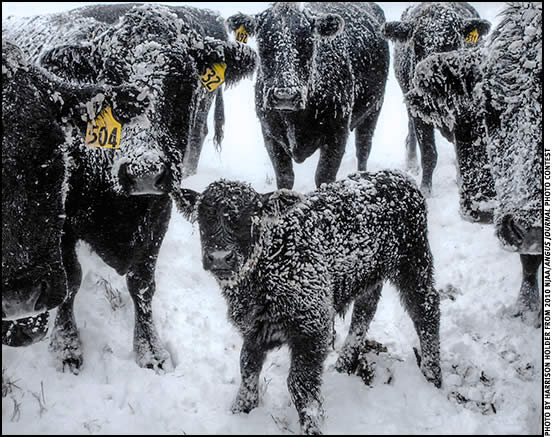
Calf Survival in the Cold
Take precautions to help newborn calves survive bitter cold.
With temperatures and resulting wind chills falling lower than the Bluegrass State has seen in nearly two decades, cattle producers need to pay special attention to newborn calves. University of Kentucky (UK) ruminant veterinarian Michelle Arnold said extra precautions would go a long way in helping calves survive.
“A calf’s body temperature often falls below normal due to a slow birth, followed by a delay in standing and nursing,” she said. “That is the immediate concern, and then the next step is maintaining the calf’s core temperature.”
If possible, producers should bring cows into the barn to calve in a heavily bedded, clean pen. If cows must calve outdoors, make sure there is dry, clean ground available without a large amount of manure. If cows do calve outdoors and calves show signs of hypothermia, or there are no natural windbreaks, producers should bring calves in until they are warm and dry.
Signs of hypothermia include shivering and blood shunting. In the early stages of hypothermia, a calf will show vigorous shivering, usually accompanied by increased pulse and breathing rate. Cold nostrils and pale, cold hooves are early signs that blood is being shunted away from the body’s extremities. Watch for erratic behavior, confusion and a clumsy gait. As hypothermia progresses, shivering stops, muscles become rigid, and pulse and respiration slow down. Brain-cell metabolism slows and impairs brain function. The calf’s level of consciousness deteriorates and signs of life become difficult to detect. The pupils of the eyes will be dilated and fixed, and it may be hard to detect a pulse. The calf may have occasional gasps of respiration, and that may be the only clue that the calf is still alive. Heart failure may be the actual cause of death.
“The two most important factors in calf survival are warmth and colostrum,” Arnold said. “Colostrum is a concentrated source of protein, vitamins, minerals and energy, and it also contains antibodies to diseases or vaccines that the mother cow has been exposed to. Before you give colostrum, you need to make sure to warm the calf because the weak ones may not have enough strength to suckle. Sometimes you may need to deliver colostrum through an esophageal feeder.”
Dark Karo syrup is a quick source of energy for calves, and their bloodstream quickly absorbs it.
UK Extension Beef Cattle Specialist Jeffrey Lehmkuhler offered several ways to warm newborn calves:
- Place calves next to floorboard heaters of pickup trucks.
- Submerse wet calves in warm baths and gradually heat the water to 100° F. Handlers need to support the calves’ heads to prevent drowning. Continue changing water out to maintain temperature.
- Place calves next to the heater in the house.
- Place calves under heat lamps, but be careful to cover the lamp with a screen so the calf will not get burned as it becomes more active.
- Wrap the calf in warm blankets, but not so hot that they burn the skin. Change the blankets as necessary to maintain warmth.
- Place the calf in a hot box or warming box, but not so hot that they burn the skin. Some type of venting is necessary to prevent carbon monoxide and moisture. Air movement is important to ensure thorough warming and to prevent hot spots in the warming box.
- A veterinarian can administer warm IV fluids.
“Once the calf is warm, provide colostrum and maintain body temperature,” Arnold said. “If the calf is unwilling to suckle and it’s not possible to milk the mother cow, you should consider commercial colostrum-replacement products.”
Calves need colostrum as soon as possible after the suckle reflex has returned, generally within the first 6 hours after birth, but ideally within the first hour or two. Once the calf is warm and fed, move it back to its mother.






